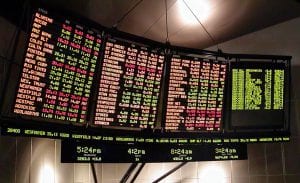
Feb 16, 2024
The Overture: Rising Wedge Pattern in Uptrend – A Prelude
The world of technical analysis is akin to a grand symphony, with various elements coming together to create a masterpiece that depicts market behaviour. Like a well-rehearsed orchestra, the financial market ebbs and flows, creating patterns that guide traders on their journey. The rising wedge pattern in an uptrend is one such pattern, playing a significant part in the ensemble of patterns.
The rising wedge pattern in an uptrend is a peculiar composition. The crescendo often signals a reversal, a market mood change. The cymbal crash echoes through the concert hall, alerting the astute trader to an impending shift in the rhythm of the market. Like a conductor reading the score, the trader must decipher this pattern, understanding its potential implications.
This pattern emerges when the market is buoyant, the prices are high, and the mood is optimistic. However, the rising wedge warns of a possible downturn, a shift to a minor key. It tells the trader that the symphony may be reaching its climax and a change in tempo is imminent.
Understanding this pattern is crucial for traders. It’s the key to reading the market and predicting its movements. Without it, the trader is like a musician trying to play without sheet music, lost in the din of the market.
The rising wedge pattern in an uptrend is the maestro’s baton, guiding the trader through the complex composition of the financial market. It’s a pivotal instrument that traders must learn to wield with precision and confidence.
First Movement: Understanding the Rising Wedge Pattern in Uptrend
An uptrend is like a harmonious melody in the financial market’s symphony, with prices rising and spirits soaring. Amid this euphoria, the rising wedge pattern emerges, a subtle yet crucial cue that the melody might be about to change. This pattern, a bearish formation amid an uptrend, is a harbinger of a possible reversal.
The rising wedge pattern begins when the market’s high and low prices increase, but not in harmony. The highs rise at a steeper rate than the lows, creating a narrowing wedge, much like the tapering end of a conductor’s baton. This discrepancy in the ascent rates is the crux of the pattern, the discordant note in the melody, signalling a potential change in market sentiment.
The formation of the rising wedge pattern in an uptrend is akin to the first movement of a symphony. It’s the slow and steady build-up, the gradual crescendo leading to the climax. It sets the stage, introduces the theme and builds anticipation for the drama yet to unfold.
Understanding this pattern is crucial for traders. It’s the key to predicting market reversals and preempting the tempo change. The musical score guides the trader through the symphony, helping them navigate the complexities of the market.
The rising wedge pattern in an uptrend is the central theme, the melody that sets the tone for the rest of the composition. It’s the note of caution in the euphoric uptrend, the whisper of wisdom amid the jubilation.
Second Movement: The Psychology Behind the Pattern
Trading, much like music, is deeply intertwined with human emotions. It is a mirror reflecting the collective sentiment, the hopes and fears, the greed and caution of the market participants amid this emotional whirlwind; patterns emerge, the most intriguing among them being the rising wedge pattern in an uptrend.
The rising wedge pattern is born of bullish sentiment, a sense of optimism angering prices. But within this bullish melody, there’s a discordant note, an undercurrent of scepticism. This scepticism is the hint of caution, the whisper of doubt that the uptrend might not last. It’s the first sign of hesitation, the slight falter in the rhythm that signals a possible shift in the market sentiment.
This pattern is a vivid demonstration of the market’s collective psychology. It showcases the tension between hope and fear, greed and caution. The bullish sentiment drives the uptrend, but the creeping scepticism causes the wedge to narrow, signalling a potential reversal. It’s a delicate balance, a dance of emotions played on the market stage.
The second movement of the market symphony, marked by the rising wedge pattern in an uptrend, is a complex interplay of psychology and economics. It’s a crucial turning point in the symphony, where the melody shifts, setting the stage for the climax. It’s the moment of suspense, the breath held in anticipation, the peaceful silence before the cymbal crash. Understanding this movement is critical to interpreting the symphony and predicting the market’s next move.
Third Movement: The Technical Analysis of the Rising Wedge Pattern
In the grand scheme of market dynamics, the analyst plays a role akin to a chess player. The market is a formidable opponent, constantly shifting and changing, requiring the analyst to think several moves ahead. To succeed in this high-stakes game, one must master the art of anticipation. One of the critical tools in an analyst’s arsenal for this is understanding the rising wedge pattern in an uptrend.
The rising wedge pattern is a complex formation, a puzzle to be solved. It begins with an uptrend, the market high on bullish sentiment. The prices rise, but not in unison. The highs ascend faster than the lows, creating a narrowing wedge. This wedge is the clue, the tell-tale sign of a potential reversal.
One needs to delve into the depths of technical analysis to decipher this pattern. It’s an intricate process, requiring keen observation and meticulous calculation. It involves studying price movements, volume trends, and other relevant market data. It’s about identifying the subtleties of the pattern, understanding its nuances, and interpreting its implications.
The third movement of the market symphony, marked by the technical analysis of the rising wedge pattern, is a journey of discovery. It’s about unravelling the mysteries of the market, about capitalizing on the opportunities hidden within its complexities. With a clear understanding of the pattern, one can strategize, plan, and execute trades, turning market volatility into a symphony of potential profits.
Fourth Movement: Contrarian Investing and the Rising Wedge Pattern
In the vast auditorium of the financial market, contrarian investing is like the soloist playing a different tune from the orchestra. The bold and confident voice dares to defy the chorus, charting its course. This approach seeks to capitalize on opportunities overlooked by the majority, finding value where others see none. The rising wedge pattern in an uptrend often presents such an opportunity.
Contrarian investing and the rising wedge pattern share a common thread – both thrive on scepticism. While the market revels in the uptrend, the contrarian investor and the rising wedge pattern see beyond the euphoria. They recognize the underlying scepticism, the subtle hints of a potential reversal. This discernment allows them to anticipate a downturn to prepare for the shift in the market’s rhythm.
Contrarian investing is not about being contrary for the sake of it. It’s about critical analysis, about questioning the status quo. It’s about recognizing patterns like the rising wedge in an uptrend and understanding their implications. It’s about seizing opportunities veiled in market volatility, turning the discordant notes into a harmonious melody.
The fourth movement of the market symphony, marked by contrarian investing and the rising wedge pattern, is a testament to the power of independent thought. It’s the bold assertion that there is value in divergence and profit in scepticism. It’s the affirmation that in the grand symphony of the market, there is room for a different tune, for a melody that dares to defy.
Finale: The Rising Wedge Pattern in Uptrend – A Conductor’s Baton in the Market Symphony
The rising wedge pattern in an uptrend is a powerful tool in the hands of an informed trader. Like a conductor’s baton, it directs the market orchestra, providing valuable cues about the possible future direction of the market.
The majestic symphony of the rising wedge pattern in an uptrend is a testament to the harmonious interplay between market trends, human psychology, and strategy. It’s a dance of numbers and sentiments, a melody that, once understood, can play to the tune of significant returns. It is a song of the market, a melody of money and a rhythm of risk and return. And understanding this symphony is akin to mastering the art of financial music.
Timeless Topics: From Classics to Current Affairs
Japan’s Economy: Abe Mulling Another Round of Stimulus
Zero Percent Mortgages Debut: Setting the Stage for Next Bull Market
Brexit’s Currency Wars: Hidden Theme for Financial Freedom
Surviving the Bear Stock Market: What’s New for Investors?
Fed Interest Rate: Negative Rates Are A Game Changer
What Economic Recovery? Most Americans Lack $1000 In Savings
Federal Reserve Interest Rate: Dangers & Benefits of Negative Rates

Why Are Interest Rates So Low: Coronavirus That’s Why
CAT Stock Price Projections And Future Trends
Why own gold in uncertain times: Protection From Disaster
HD stock quote And future price trends
Valeant Shares Slump



